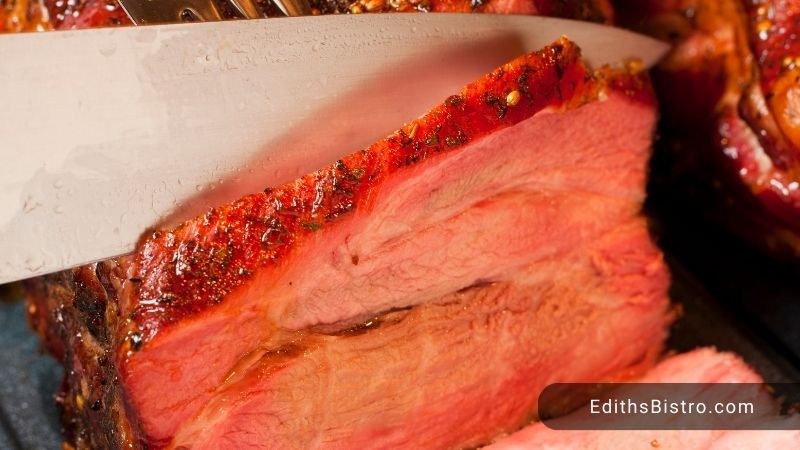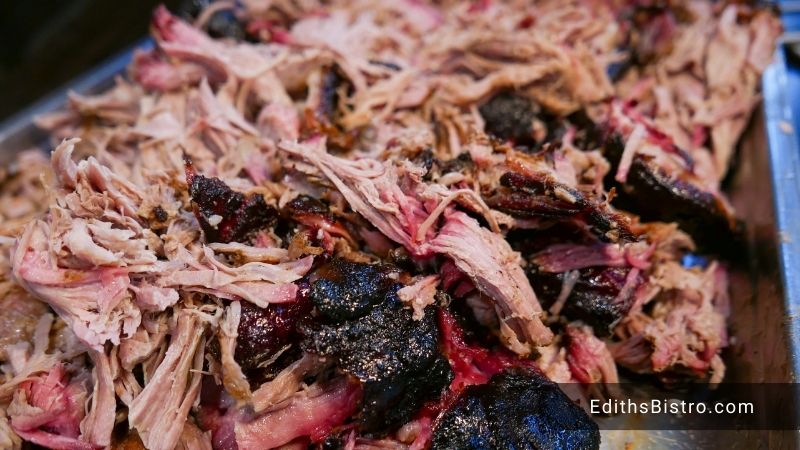You’ve finally reached the peak of pork perfection after hours of smoking. Before digging into that juicy pulled pork, it’s crucial to let it rest. But exactly how long to rest pork butt? Uncover the secrets of resting times for peak flavor and tenderness.
How Long To Rest Pork Butt?

The ideal rest time before pulling is 1 to 2 hours. Resting gives time for the juices and moisture forced out during cooking to reabsorb into the meat. For a 10-15-pound smoked pork, aim for 1.5 to 2 hours of resting time wrapped in a cooler or oven after cooking. Smaller, 5-7-pound pork need about 1 hour to rest. Proper resting transforms even the toughest cuts into fork-tender perfection.
Benefits Of Letting Pork Rest After Cooking
Instead of merely telling you the duration for resting pork shoulder, we’re eager to delve into the rationale behind it. Allowing pork to settle post-cooking brings about numerous important advantages. Here’s a straightforward breakdown of those benefits:
- Juicier Meat: The heat pushes the juices towards the center when you cook pork. Resting allows these juices to be redistributed, making the meat juicier.
- Better Flavor: As the juices redistribute, they carry flavor throughout the meat. This makes every bite as tasty as possible.
- Easier to Cut: Resting helps the meat firm up a bit, making it easier to cut. This is especially useful when slicing pork roasts or chops.
- Continues Cooking: The residual heat cooks the meat slightly during rest. This can help ensure your pork is cooked perfectly, especially if it was just under the target temperature when you took it off the heat.
- Enhanced Texture: The resting phase allows the muscle fibers to relax and reabsorb the juices, resulting in a more tender, succulent texture.
Allowing your pork to rest after cooking ensures a more flavorful, juicy, and satisfying meal. So, remember to factor rest time into your cooking plans – it’s worth the wait!
How Long To Let Pork Rest After Smoking?
After smoking, you should let the pork rest for at least an hour after removing the smoker. But how long to rest pork butt exactly? However, the exact resting time can depend on the size of the meat. Here’s a simple guide:
| Pork Size | Recommended Resting Time | Why |
|---|---|---|
| 5-7 lb | At least 1 hour | This gives the juices enough time to redistribute throughout the smaller cut of meat. |
| 10-15 lb | 1.5 to 2 hours | Larger cuts of meat require a longer rest time to allow the heat and juices to evenly distribute. |
Resting is crucial to achieve a tender, juicy, and flavorful pork butt. Here are the key points:
- Don’t Rush: Allow adequate rest time based on the size of your pork. The wait is worth it for the flavor and tenderness it brings.
- Stay Wrapped: Keep the pork wrapped in foil during rest to retain heat and moisture.
- Minimum 145°F: Ensure the internal temperature of the meat stays above 145°F after resting to guarantee it is fit for consumption.
Take the time to rest your smoked pork properly, and you’ll be rewarded with a melt-in-your-mouth meal.
How To Rest A Pork Butt After Cooking
Resting your pork after cooking is crucial for tender, juicy meat. Here’s a step-by-step guide to do it right:
- Remove from Heat: Once your pork reaches the ideal internal temperature (usually between 190-205°F for pulling), remove it from the heat source.
- Wrap It Up: Wrap the pork in aluminum foil. You can also wrap it in a clean towel for an extra layer of insulation and to capture any escaping juices.
- Let It Rest: Place the wrapped pork in a cooler or an unused oven. The goal is to keep it warm and allow the juices to return throughout the meat. This step makes your pork more flavorful and easier to shred or slice.
- Wait Patiently: Let the meat rest for at least an hour. Larger cuts may require up to two hours. Patience is key here. This is when your pork continues to cook, and the connective tissues break down further, making it incredibly tender.
- Check the Temperature: After resting, ensure the meat’s temperature is still above 145°F before pulling or slicing. This is the recommended minimum temperature for consumption to ensure it’s properly prepared.
- Pull or Slice: Unwrap the pork and pull apart with two forks, or slice. If done right, it should be tender and easy to pull apart.
What Not To Do When Resting Pork Butts
Resting pork after smoking is vital in achieving tender, juicy meat. However, there are some common mistakes to avoid:
- Don’t Skip Resting: It’s tempting to start pulling the pork immediately after smoking, but don’t. The juices need time to redistribute, which won’t happen without proper resting.
- Avoid Uncovering Too Soon: Keep the pork wrapped in foil during the rest period. Unwrapping it too soon can release heat and moisture, leading to dry meat.
- Don’t Use a Hot Environment: Don’t rest the meat in a hot environment like a preheated oven or directly in the sun. The goal of resting is to allow the meat to cool slowly, not to continue cooking it.
- Don’t Rush: Resting requires patience. Rushing this process can result in less tender and flavorful meat.
- Avoid Cutting Into It: Resist the urge to cut the meat during rest. Cutting lets out juices that make the meat moist and tasty.
- Don’t Ignore Temperature: After resting, ensure the internal temperature of the pork is above 145°F before pulling or slicing.

Avoiding these common mistakes will reward you with a perfectly rested, juicy, tender pork shoulder. Remember, patience is key in the resting process. The wait will be worth it!
FAQs
Does pork need to rest after cooking?
Yes, pork should rest after cooking to allow juices to redistribute, improving flavor and tenderness.
Do we rest pork shoulder wrapped or unwrapped?
Resting pork shoulder can be done either wrapped or unwrapped, but wrapping retains more moisture.
Is pulled pork better at 190 or 205?
Pulled pork is often more tender and easier to shred at 205°F, although it’s edible and flavorful at 190°F.
References
- Pulled pork: https://en.wikipedia.org/wiki/Pulled_pork
- Pulled pork, with barbecue sauce: https://fdc.nal.usda.gov/fdc-app.html#/food-details/173344/nutrients






![What To Pair With Quiche? 25+ Best Dishes [With Pictures]](https://www.edithsbistro.com/wp-content/uploads/2024/04/what-to-pair-with-quiche-160x90.jpg)
